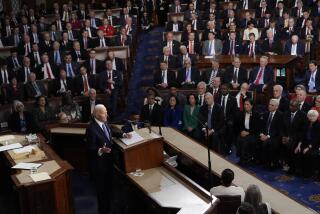Jobless Rate Remains at 7-Year High : Economy: Nationwide unemployment is at 7.3%, while California’s level inches down to 8.5%.
WASHINGTON — Despite tentative signs of recovery in some sectors of the economy, the nation’s unemployment rate remained stuck in March at 7.3%, the highest level in almost seven years, the Labor Department reported Friday.
In California, the rate fell from 8.7% in February to 8.5% last month as the number of jobless workers in the state dropped to 1,278,000, a decline of 39,000, and total employment edged up slightly to 13,785,000.
Even so, new job losses were reported in such key California industries as manufacturing, retail, finance and transportation, while construction posted an unexpected spurt in hiring. Despite the slight decline in overall unemployment, California’s jobless rate was surpassed only by Michigan, Massachusetts and Florida among the major industrial states.
Nationally, analysts have cited recent gains in housing construction, retail sales and factory orders as evidence that the longest-running recession since World War II finally is ending. But those flickers of recovery have not yet generated significant job growth, leaving the unemployment rate at its highest level since July, 1985.
“Spring may be here, but the economy still feels like winter,” said Sen. Paul Sarbanes (D-Md.), chairman of the Joint Economic Committee of Congress during a hearing Friday on the March jobless figures.
Economists say that it is typical for unemployment to remain relatively high during the initial stages of a recovery. Many employers delay hiring new workers in response to rising demand until they are sure that the rebound will continue.
“It will take some time for the jobless situation to improve,” said Rep. Thomas Downey (D-N.Y.), adding that the latest figures underscore the need to extend and improve unemployment benefits.
According to the Labor Department’s monthly survey of households, the number of working Americans increased by 300,000 in March. The civilian labor pool grew by 305,000, the government said, as more people entered the work force. Because the two numbers were nearly equal, the jobless rate remained unchanged.
A separate survey of employers showed that non-farm payrolls increased by a minuscule 19,000 last month, a relatively feeble comeback from the 20-month economic slump. And February’s employment gain was revised down to 107,000 jobs from the 164,000 reported a month ago. The employer survey is considered a more reliable gauge of employment than the household poll.
“It’s really too early to expect anything to happen in the labor market,” said Kenneth Goldstein, an economist with the Conference Board, a research organization in New York. “This process could take all summer before we see employers turn on a dime from laying off folks to starting to put them back on.”
Nevertheless, analyst Roger Brinner of Data Resources, a consulting firm in Lexington, Mass., said the slight improvement in total employment is encouraging and predicted that larger gains will be recorded in coming months.
“It’s not going to be a barn-burner of a recovery . . . but we have passed bottom,” Brinner said. “The improvement should be enough to bring the unemployment rate down to 6.7% by the (November) election, and that would help (President) Bush.”
The March figures were characterized as “really anemic” by Mike Penzer, senior economist at Bank of America, who said that the gains in payroll employment were only a fraction of the job growth experienced in past recoveries.
Penzer noted, however, that healthy gains in consumer spending and retail sales in January and February should set the stage for a healthier job market in the second quarter.
California’s job performance last month was termed “very poor” by Joseph A. Wahed, chief economist at Wells Fargo Bank in San Francisco. “If I had to give it a report card, I’d give it an F,” Wahed said.
The latest monthly figures follow disclosures that government officials had dramatically underestimated the jobs lost in California last year. The revised figures show that 333,000 jobs vanished, more than six times the loss indicated by initial reports. And much of the state’s economic woes were centered in Los Angeles County.
For March, the California Employment Development Department said that factory employment dropped by 13,400 and retail jobs fell by 2,900, offset by a surprising gain of 19,100 in construction. Overall, non-farm payroll employment dipped by 2,500 in the state last month.
On a national basis, 9.2 million people were seeking work and unable to find a job in March, an increase of 2.5 million over the level of unemployment when the recession started in mid-1990, the government said.
Of the total number of unemployed Americans, 1.8 million were jobless for six months or more, an increase of 1 million over the pre-recession figure. In addition, 6.5 million people who wanted full-time jobs were working part time last month, while 1.1 million wanted jobs but stopped looking for work because they believed that the search would be fruitless.
The survey of payroll employment showed some moderation last month in the extent of layoffs as well as small job gains in some sectors. The auto industry, for example, added 6,000 jobs in March, a gain of 73,000 over the last 12 months but 83,000 below the pre-recession peak.
Manufacturing employment dipped a mere 3,000 in March, following five consecutive months of much larger job losses. Construction, where the jobless rate is 17.6%, posted a modest gain of 10,000 jobs after adjustment for seasonal factors.
Times staff writer Jonathan Peterson in Los Angeles contributed to this report.
More to Read
Get the L.A. Times Politics newsletter
Deeply reported insights into legislation, politics and policy from Sacramento, Washington and beyond. In your inbox three times per week.
You may occasionally receive promotional content from the Los Angeles Times.










